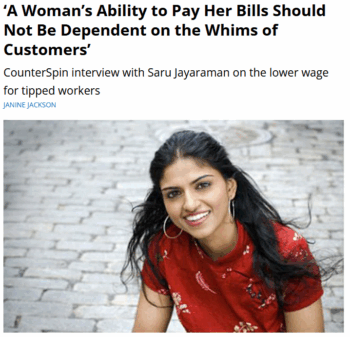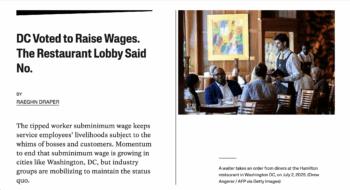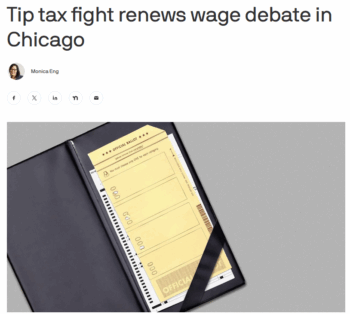Janine Jackson interviewed the CHAAD Project’s Raeghn Draper about tipped workers for the August 8, 2025, episode of CounterSpin. This is a lightly edited transcript.

CounterSpin (11/27/15)
Janine Jackson: When CounterSpin spoke with Saru Jayaraman in 2015, she described the subminimum or tipped wage as something most people outside restaurant and hospitality work know almost nothing about, including legislators. The tipped wage at that time was $2.13 an hour. Now, 10 years later, the tipped wage is…$2.13 an hour.
But some things are changing, including increasing public understanding of the wrongness of a system that forces service workers to rely on customers’ whims and bosses’ greed, and the growing number of workers rising in resistance.
Our guest is part of that work. Raeghn Draper is co-founder and executive director of the CHAAD Project, created by and for hospitality workers in Chicago to advance accountability and end labor abuses in the industry. They join us now by phone. Welcome to CounterSpin, Raeghn Draper.
Raeghn Draper: Thanks for having me.
JJ: I feel as though almost everyone knows, or is, someone who has worked restaurant/hospitality, but if you don’t have that knowledge, you might be confused by the official description of the tipped wage, which says
an employer of a tipped employee is only required to pay $2.13 cents per hour in direct wages if that amount, combined with the tips received, at least equals the federal minimum wage.
So for many people, that might sound like, “Well, at the end of the day, everyone ends up with the federal minimum wage,” whatever you think about that. But if it were just a minimum wage issue, which is of course an important fight, the resistance wouldn’t look the way that it does.
And so I wonder, what are some of the particulars that people, including people who eat at restaurants a lot, might not know about?
RD: I think what people don’t know about when they think of the tipped wage is the deep inequities that are baked into the tipped wage. So while the idea is that tips will bring those workers up to the minimum wage, it is far too common that that is not the case.
We find that places that have tipped workers are more likely to experience wage theft. There’s deep racial inequity in the tipping system, with white men getting tipped at higher rates than Black women, for example.
There’s higher rates of sexual harassment and sexual assault when the tipped wage is involved, because of the power dynamics, both with guests and with employers. So workers aren’t able to set boundaries that they might be able to in places where their wage doesn’t depend on their behavior and how well they perform.
So outside of how much money you make with the tipped wage wage, there’s still these deep inequities that come with it.

Jacobin (7/30/25)
JJ: I appreciate that. I would refer folks to the Saru Jayaraman conversation, which gets into some of the history, and the racial and gender inequities that you’re talking about, and it’s deep, and it’s a long story. But I really want to focus on the present and the future, as much as the past is involved there.
Your recent piece for Jacobin describes what happens when not just restaurant hospitality workers, but everybody who understands and objects to this two-tiered wage system, when they say, “OK, we want to abolish it”—so talk us through a little bit what happened in DC, because voters spoke, right?
RD: Yeah, voters spoke actually twice in DC, wanting to abolish the subminimum tipped wage. I’m based in Chicago, that’s where my labor work is. And I started looking into what’s happening in DC because in 2023, the Chicago City Council implemented the One Fair Wage ordinance, which will phase out the subminimum tipped wage, which we viewed as a victory for workers.

Axios (6/27/25)
There has been pushback, both from the National Restaurant Association and from our local chapter, the Illinois Restaurant Association and their partners, and from prominent restaurant owners, CEOs and large groups. We even had an alderperson of the 44th ward, Bennett Lawson, introduce a new ordinance that would pause the ordinance that was put in place in 2023.
All of this is very concerning to me, so I started digging into what is happening in other states. There are states who have implemented the One Fair Wage across the state, but what was happening in Chicago was, because of the fight in DC, the NRA, the Illinois Restaurant Association, the large restaurant groups and owners, were using DC as a talking point to show that the One Fair Wage is failing. They were pointing to the fight that has happened in city council there to show how it’s harming restaurants, and that the city doesn’t actually want this, and the restaurant community doesn’t actually want this, and so we need to reverse this harmful ordinance, otherwise our industry will collapse.
And so that’s why I started digging into what’s happening in DC, because it kept being used as an example. And as I dug deeper into the facts or the data points that were used, something that their local chapter, the Restaurant Association of Metropolitan Washington, was using was this 44% number. They kept saying, over and over, that 44% of full-service restaurants expect to close or are likely to close by the end of 2025.
And I went down this deep rabbit hole, very long Google doc of research and links and circling around the internet. But at the end of the day, what I found was they polled what looks to be their members—so restaurants who are bought into their organization—they polled those, and just put them on a scale of how likely do you think you’re going to remain open. The vast majority said somewhat likely, a smaller percentage said very likely. And they pulled this number together to be the 44% that they then used as their leading campaign number, to really spearhead their arguments.
They also threw around the number of closures that had happened in most recent years, specifically in 2024, I believe they were looking at, I think it was 53 closures that they said was the fault of raising the wages. But again, as I dug into the internet, and went through all these loopholes, I found that a very small percentage, probably about three to five of those 53 restaurants that closed last year, said part of their reasoning was because of wages. Some of them weren’t even using tipped labor. A large portion of them said that high rates of rent and disagreements with landlords was why they were closing, or even just moving locations.

Raeghn Draper: “All of the outlets that were covering this issue…they were quoting the Illinois Restaurant Association. They weren’t quoting workers.”
But still, this is the image that was painted in DC, and that narrative was coming over to Chicago. It also was really upsetting to me that, if you dig a little bit deeper, it isn’t so black and white as they painted it. Not only were the numbers that they were using faulty, DC produced their own independent report on the state of the DC restaurant industry, and they found it was doing relatively healthy, stable numbers, restaurants closed but also restaurants open. There was no dramatic loss in jobs. Pay was increasing, overall a pretty stable industry. But again, that wasn’t the story that these large restaurant groups were sharing, which is very disturbing to me, because these were the most vocal in all of the pieces that I read.
And all of the outlets that were covering this issue, they were quoting the RAMW, they were quoting the NRA, they were quoting the Illinois Restaurant Association. They weren’t quoting workers. They weren’t asking workers what they thought about the higher wages, which I thought was very disturbing, because who does this ordinance most impact? I feel like it’s workers, it’s our wages, it’s our paychecks, but they were effectively silenced. So that’s what kind of led me through writing this piece.
JJ: Absolutely. And one of the big beefs with corporate media is precisely this maneuver, where they indicate that there’s something that sounds good, you know, raising wages for workers, but then, “Oh, it’s not actually good, even for the people pushing it, even for the workers themselves, because they just don’t understand the bigger picture,” which is this mythology around, “They think they want higher wages, but then the restaurants are going to close, and they won’t get any wages.” And it’s this simplistic patronizing picture.
What I love is that fewer and fewer people are buying it, frankly. But I feel like that is what media are selling, is both a workers vs. consumers view, but also an idea that somehow there’s a way that getting higher wages for workers is going to be bad for workers. It should be a hard line to sell, but corporate media help them sell it.
RD: Absolutely. I think that is happening, not just in the restaurant industry, but across our country, pitting workers against what is actually going to benefit them. I think we saw that with the Big Beautiful Bill: absolutely detrimental to all working class and low-income folks across the nation, but presented as a win for workers with the tax on tips being slipped in there.
And I think we see that with a lot of these policies and legislation that are painted as a win for workers. We will give you this little carrot, but we’re actually going to strip autonomy and power away from you in the long term. And I do believe that people are waking up to it, and they’re tired of being fed crumbs.
JJ: Well, I should have ended there, but I do want to point out that in your Jacobin piece, you make clear that the storyline is not working out, in the sense that those places that do have the One Fair Wage, they’re not showing these horrible effects. So it’s not just a narrative, there’s also a reality that doesn’t match up to what they’re trying to warn people about.
RD: Absolutely. And it doesn’t exist in any of their arguments. When these groups want to talk about the harm that raising wages will do to the industry, they don’t want to look at states that have implemented One Fair Wage, and have abolished the two-tier tip system. They’re completely erased from the argument in the narrative, which just goes to show, they’re not about workers. They’re not really about the overall health of the restaurant industry. They’re about consolidating their power, and keeping themselves on top. And the two-tiered system works for them.
JJ: We’ve been speaking with Raeghn Draper, co-founder and executive director of the CHAAD Project. That’s Chad with two A’s, TheCHAADProject.org. Raeghn Draper, thank you so much for joining us this week on CounterSpin.
RD: Thank you.
This content originally appeared on FAIR and was authored by Janine Jackson.